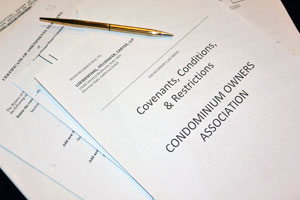LHC NEWSLETTER, VOL. 11, NO. 2
Planning and Preparing for Major Component Projects
By: David A. Loewenthal, Esq.
Kevin P. Carter, Esq.
Loewenthal, Hillshafer & Carter, LLP
Your association is about to enter into a construction contract. What does this
mean? How do you figure out what is fair and reasonable? What should be included and excluded? What should we do? All of these and a myriad of other questions always arise when an association/owner is about to enter into a substantial construction contract.
Initial Guidance:
The following are essential terms and conditions that should be included in any
construction contract by and between an association/owner and a general contractor. Be wary of construction contracts provided by general contractors to an association. Not surprisingly, general contractor contracts tend to be very favorable towards the contractor since they are the party that has prepared the draft contract.
An association should never simply accept the contract provided by the general contractor without a thorough review and understanding of its terms and conditions. Though there is an expense involved, any construction contract that is monetarily sizable, impacts common area components which, if not properly constructed, can create liability for the association, cause the association monetary damage and/or damage to the association property and/or individual units, should be reviewed by counsel. It is better to be cautious upfront, prior to entering into the contract, than learning of the deficiencies with the contract once a problem has arisen.
Pre-Contract Background Check and Due Diligence:
Prior to the preparation and/or review of a construction contract, the association must first take the necessary steps to ensure that the proposed contractor is actually qualified for the project. This includes, but is not necessarily limited to, having the proper license(s) to perform the construction project, bonded, insured (automobile, workers compensation and general liability), and is experienced in the type of project that you are seeking to contract for.
Once the background check has been completed, it is imperative that the contract contains certain critical terms and conditions so that all of the parties understand the rights, duties and obligations pursuant to the contract.
Essential Terms and Conditions of a Construction Contract:
- Type of Contract:
-Fixed Cost Contract: All of the work is to be performed for an agreed sum of money determined prior to executing the contract.
-Time and Material: Contractor charges an hourly rate for all labor and time as well as for material and surcharges. The association does not know what the actual cost of the construction project will be at the time of contracting.
-Cost Plus: The association pays for the actual costs/expenses of the project including labor, subcontractors, material supplies, etc., plus a fixed percentage or monthly fee to the general contractor for overhead and profit.
-Guaranteed Maximum: Contractor sets a maximum price for the cost of the work plus an agreed upon profit with provisions for the contractor to obtain competitive bidding from subcontractors. This may also include a cost savings provision. Note: contractor responsible for cost overrun unless based upon agreed change orders.
- Scope of Work/ Representation and Warranties:
The contract needs to specifically identify the job description/scope of work. As part of the description, the contract should reference the approved plans, specifications, engineering documentation as well as written descriptions of the work.
A representation should be included in the contract stating that the contractor will comply with the city approved plans, specifications, industry standards and building codes.
If the contract calls out for specific materials, name brands, manufacturers, etc. that should be included in the contract.
Further, exclusions to the contacts should be specifically identified so as to avoid ambiguity as to the scope of work during the construction.
Avoid ambiguity upfront.
- Commencement and Completion of Work/Time is of the Essence/ Liquidated Damages:
Associations generally have a specific time frame in which they expect the work to be completed. This is especially important when the construction involves waterproofing, such as a new roof, which needs to be completed prior to winter rains.
The contractor needs to provide sufficient forces to ensure that the work is completed within the designated timeframe with exceptions for force majeure events.
In order to help ensure timely completion of a construction project, the inclusion of a liquidated damages provision may be appropriate. Such a provision requires the contractor to either forfeit monies otherwise owed under the contract or repay money to the association for each day the contract goes beyond the initial completion date. This can be limited based upon change orders agreed to by and between the contractor and the association as well as force majeure events (acts of God, war, labor strikes, etc.).
- Payment Schedule/Retainage:
Depending upon the type of contract entered into, an appropriate payment schedule is essential.
The contractor cannot require more than ten percent (10%) of the contract amount or $1000, whichever is less, at the time of entering into the contract.
The contract should be written so that the associations payment is always owed after the work, that is the subject of the payment, has been performed. The association should not pay for work not yet performed. The timing of payment provides significant leverage to the association.
At a minimum, the association should negotiate upfront a 10% retainage to be paid once the project has been completed including all punch list items performed, final sign-off/ approvals received from governmental authorities and the providing of lien releases from all subcontractors, material suppliers, vendors and the general contractor.
- Change Orders and Cost Contingencies:
Many “fixed cost” contracts contain a cost contingency. A contingency is an estimate and not a promise as to what that item will cost. There are situations where a cost contingency is fair and reasonable and there are other situations in which an association should ask for the actual cost. Such contracts also often included an “allowance” providing a certain amount of money for an item, such as windows, cabinetry, tile, etc.
In addition, change orders are often reasonable and necessary. To avoid being “change ordered to death”, the contract should require change orders to be in writing and signed by the contractor and the client. The contract should also require a reasonable level of specificity for change orders including, but not limited to, anticipated delay (if any), cost and detailed scope of work.
- Insurance and Performance Bond:
The general contractor and all subcontractors must have all appropriate insurance including automobile, workers compensation and general liability. Regarding general liability, require written confirmation that there are no exclusions for work performed on a common interest development/multi-family residential project since that is a standard exclusion in many contractors liability insurance policies.
Also require that the contractor name the association and community association management company as additional insureds under the general liability policy. By being added as additional named insureds, the association/management company will have direct contractual rights with respect to the insurance policy in case of any liability claim.
Especially regarding the liability insurance, the policy limits should be more than enough to cover damages should the work performed be deficient.
Depending upon the size of the project, you may also require a performance bond, which is generally two to three percent (2%-3%) of the contract amount. The contractor may require that to be a cost paid by the association. A performance bond can come into play if the association has pre-paid for work and the contractor fails to complete its work, possibly triggering the bond company to pay for completion of the work.
- Indemnity:
Often the contractor will require the association to indemnify, defend and hold harmless the contractor in the event of a claim. The provision should be reversed and written in favor of the association so that in the event of a claim arising from the acts and/or omissions on the part of the contractor that give rise to damage or injury, the contractor will defend, indemnify and hold harmless the association.
This provision is extremely important especially when the construction project will involve significant renovation to a project which has the potential to damage individual units that could lead to homeowners bringing a claim against the board or the association for related damage.
The insurance provisions, including being named as an additional insured, along with indemnity are essential provisions that need to be included within a construction contract to properly protect the association.
- Limitation on Liability/ Exculpatory Clauses:
A contractor should be prepared to stand behind his work and accept responsibility if he provides deficient services. Contract clauses attempting to limit liability for defective work take many forms, but each takes away rights associations have under California law.
Such clauses should either be fully eliminated from a contract or properly negotiated so as to limit their impact. Examples of such clauses are as follows:
– “Contractor shall not be liable to association for any acts and omissions other than intentional or grossly negligent acts”;
– “Contractors liability for damages is limited to the dollar amount paid the contractor under the contract”;
– “Association agrees to waive any and all consequential damages arising from contractor’s work.”
Again, in negotiating the contract, these provisions should be deleted, if possible, or, at a minimum, significantly modified so as to properly protect the association.
- Termination Clause:
This is a standard provision in construction contracts. The provision should be viewed in several parts: (1) who is the terminating party (owner or contractor) and (2) is the termination for cause or without cause.
To the extent that the association can negotiate the right to terminate without cause (simply for convenience), that is beneficial. In such an event, the contract should attempt to limit any termination fees to be paid by the association to the value of the work/services performed up through the date of termination and possibly certain limited additional costs involving demobilization.
The methodology of termination and the associated fees are generally negotiable.
- Alternative Dispute Resolution Mediation/Attorney Fees:
Parties to a construction contract often focus on the actual work to be performed without thought as to what happens in the event of a dispute down the line.
In anticipation of a potential dispute/claim the parties may wish to include in the construction contract a mediation provision stating that in the event of a dispute or claims prior to instituting a formal lawsuit, the parties will first attempt to resolve the disputes/claim through the use of mediation. Such mediation is typically performed through the use of a third-party neutral who is either a retired judge or an attorney with significant experience in this field. There are several large and individual mediation services throughout California.
The provision is generally written so that if a party institutes litigation without first proceeding to mediation that the party waives its rights to recover attorneys fees.
An essential hammer in any construction contract is an attorneys fees provision. The provision generally states that in the event of an action (litigation or arbitration) arising from the contract or the work performed therein, the prevailing party in any such action is entitled to the recovery of reasonable attorneys fees and costs as well as expert consultant fees and costs.
Board/ Association Liability:
A primary purpose and obligation of an association and its Board of Directors is to properly assess for the maintenance, repair and replacement of the common area which is largely premised upon the duty to perform a reserve study at least once every three years.
A board/association can be found in breach of such obligations for failure to properly maintain, repair and replace the common area. As such, there is always potential liability as to the association and the board for failing to carry out those primary functions.
Such duties and obligations, including visual inspections of exterior elevated elements, such as decks/ balconies, have been recently codified in (SB 326) Civil Code sections 5551, 5986 and 6150. Inevitably, these new statutes will lead to additional construction projects that will be the subject of construction contracts.
An association will live and die by the construction contract it enters into. Being thoughtful and careful upfront in the negotiation and drafting of the contract will save an associate tremendous time, cost, expense and heartache in the event of a dispute.


